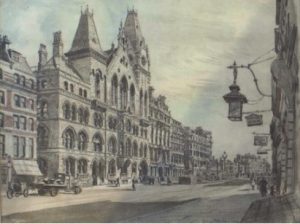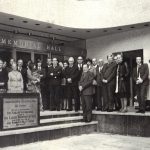The Congregational Memorial Hall was built in Farringdon Street, London to commemorate the 200th anniversary of the Great Ejection on what became known as Black Bartholomew’s Day, resulting from the 1662 Act of Uniformity which restored the Anglican church. The two thousand ministers who refused to conform thereby established non-conformism.
The original Trust Deed of Foundation of 5 July 1872 established a fund for –
“erecting a fitting memorial to the piety and learning and Christian zeal and devotedness of the noble band of Ministers of the Gospel who, on St Bartholomew’s Day in the year 1662 preferred to resign their benefices upon which many of them wholly or mainly depended for their earthly subsistence, rather than conform to rites and usages in worship of God contrary to that which they believed to be the truth of his Gospel as declared in Holy Scripture”
The fund was placed in the hands of Trustees to be used as they thought fit to achieve this object. Trustees were empowered to –
- encourage and assist the studies or researches of members of Bible classes…..
- permit the Library to be used for reference, meetings of Christian or philanthropic organisations…..
- erect the Hall and Library and after completion, to use monies left over and all subsequent income for the purpose of running the Hall and Library.
Many famous names were associated with the membership of the Trust during this period including ministers, political, civic and industrial leaders including:
John Remington Mills, Treasurer and Chairman
Revs Henry Allon, RW Dale, Alexander Hannary, Alexander Raleigh, John Stoughton, David Thomas, Charles Wilson.

The original Memorial Hall was built upon the site of the Fleet Prison in Farringdon Street. It was designed by the architect John Tarring who designed many Gothic Revival churches for Nonconformist clients and was an outstanding piece of Victorian architecture. It opened in 1875 and served as a meeting place and home for the Congregational Library. During its hundred years of life it lent distinction to Farringdon Street by its unique appearance and its many towers and turrets.
Famous political figures met there, the Labour Party was formed in its rooms in February 1900 initially under the name of the Labour Representation Committee, the General Strike of 1927 was run from the Hall and the BBC had for many years a popular studio in its Great Hall.
During WW2 the Library premises, Board Room and Kitchen were taken over by the London City Council as a Meals Service Restaurant. Though highly successful as such, it reduced the premises to a deplorable condition. Some years after the war it became apparent that it would not be economical to continue maintaining the premises in the old form and the Trust had then little in the way of reserves.

After ten years of planning and numerous setbacks, the Hall was demolished in 1968, two adjoining premises were acquired and the plans for a new building, to be named Caroone House, were passed. Part of the new building was occupied by a branch of International Telephones of the Post Office, with the northern end of the building covering approximately 10,000 sq. ft. housing the Congregational Library and Meeting rooms retained by the Trust under the name of The Memorial Hall. The opening ceremony for the new Hall took place on 5th September 1972, when Dr John Huxtable took part and the Rev Howard Stanley gave an address.
The original Deed of Foundation was varied by various Charity Commission schemes (1938,1969,1982,2001)
On 23 September 1969 the Trust incorporated as The Congregational Memorial Hall Trust Limited. The Trust managed income from Caroone House and then from the capital raised from its sale.
On 15th September 1978 the name of the company changed to its current style (The Congregational Memorial Hall Trust (1978) Limited) and new Memorandum and Articles of Association came into force but still retaining the original objectives of the Foundation. The new governing document had become necessary with the formation of the United Reformed Church in 1972, and the Trustee Body was reconstituted to include representatives of the URC, the Congregational Federation and the Evangelical Fellowship of Congregational Churches.
In 1982, the Library, was moved to 14 Gordon Square to be housed with and administered by Dr Williams’s Library.
In 2010, half of the Trust’s financial assets were distributed in specie to the United Reformed Church, Congregational Federation, and the Evangelical Fellowship of Congregational Churches.
Each year surplus investment income not required for the maintenance of the Congregational Library is distributed to the three church bodies.
In 2022, the Library’s connection with Dr Williams’s Library came to an end and the Trust’s Council and Library Committee are exploring new partnership possibilities.
